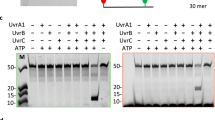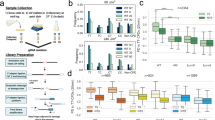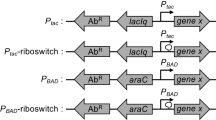Abstract
UvrA+-dependent excision repair1, 2 is one of the most important systems in Escherichia coli for repairing UV-induced pyrimidine dimers1 and a variety of other forms of DNA damage3, 4. The uvrA protein acts in conjunction with the uvrB and uvrC gene products to introduce a nick at the site of a DNA lesion and thus initiate the repair process1. We have recently used the Mud(Ap, lac)5 operon fusion vector to identify a set of genes whose expression is induced by DNA damage. One Mud(Ap, lac) insertion mapped at the uvrA locus and made the cells sensitive to UV light. In this fusion strain, β-galactosidase expression was induced by DNA-damaging agents in a recA+ lexA+-dependent fashion6. We were surprised by this result because uvrA+-dependent excision repair is observed both in cells in which protein synthesis has been inhibited7 and in recA− and lexA− cells8, findings which have led to the conclusion that the uvrA gene product is constitutively expressed and not under the control of the complex recA+lexA+ regulatory circuitry9 (see below). We have investigated this possibility further and describe here the generation and characterization of a set of fusions of the lac genes to the promoter of the uvrA gene. We confirm that the uvrA gene product is induced by DNA damage in a recA+lexA+-dependent fashion.
This is a preview of subscription content, access via your institution
Access options
Subscribe to this journal
Receive 51 print issues and online access
$199.00 per year
only $3.90 per issue
Buy this article
- Purchase on Springer Link
- Instant access to full article PDF
Prices may be subject to local taxes which are calculated during checkout
Similar content being viewed by others
References
Seeberg, E. Proc. natn. Acad. Sci. U.S.A. 75, 2569–2573 (1978).
Hanawalt, P. C. Cooper, P. K., Ganesan, A. K. & Smith, C. A. A. Rev. Biochem. 48, 783–836 (1979).
Ikenaga, M., Ichikawa-Ryo, H. & Kondo, S. J. molec. Biol. 75, 341–356 (1975).
Boyce, R. P. & Howard-Flanders, P. Z. VerebungLehre. 95, 345–350 (1969).
Casadaban, M. J. & Cohen, S. N. Proc. natn. Acad. Sci. U.S.A. 76, 4530–4533 (1979).
Kenyon, C. J. & Walker, G. C. Proc. natn. Acad. Sci. U.S.A. 77, 2819–2823 (1980).
Boyle, J. M. & Setlow, R. B. J. molec. Biol. 51, 131–144 (1970).
Clark, A. J. & Volkert, M. R. in DNA Repair Mechanisms (eds Hanawalt, P. C., Friedberg, E. C. & Fox, C. F.) 57–72 (Academic, New York, 1978).
Radman, M. in Molecular Mechanisms for Repair of DNA (eds Hanawalt, P. C. & Setlow, R. B.) 355–367 (Plenum, New York, 1975).
Faelen, M., Huisman, O. & Toussaint, A. Nature 271, 580–582 (1978).
Miller, J. H. Experiments in Molecular Genetics (Cold Spring Harbor Laboratory, New York, 1972).
Howard-Flanders, P., Boyce, R. P. & Theriot, L. Genetics 53, 1137–1150 (1966).
Ishii, Y. & Kondo, S. Mutat. Res. 27, 27–44 (1975).
Kondo, S., Ichikawa, H., Iwo, K. & Kato, T. Genetics 66, 187–217 (1970).
Sancar, A. et al. J. molec. Biol. (submitted).
Witkin, E. M. Bact. Rev. 40, 869–907 (1976).
Mount, D. W. Proc. natn. Acad. Sci. U.S.A. 74, 300–304 (1977).
Brent, R. & Ptashne, M. Proc. natn. Acad. Sci. U.S.A. 77, 1932–1936 (1980).
Little, J. W., Edmiston, S. H., Pacelli, L. Z. & Mount, D. W. Proc. natn. Acad. Sci. U.S.A. 77, 3225–3229 (1980).
Roberts, J., Roberts, C. & Craig, N. Proc. natn. Acad. Sci. U.S.A. 75, 4714–4718 (1978).
Morand, P., Blanco, M. & Devoret, R. J. Bact. 131, 572–582 (1977).
Mount, D. W., Walker, A. C. & Kosel, C. J. Bact. 121, 1203–1207 (1975).
Rothman, R. H., Margossian, L. J. & Clark, A. J. Molec. gen. Genet. 169, 279–287 (1979).
Walker, G. C. & Dobson, P. P. Molec. gen. Genet. 172, 17–24 (1979).
Swenson, P. A. & Setlow, R. B. J. molec. Biol. 15, 201–219 (1966).
Cooper, P. K. & Hanawalt, P. C. Proc. natn. Acad. Sci. U.S.A. 69, 1156–1160 (1972).
Low, K. B. Bact. Rev. 36, 587–607 (1973).
Author information
Authors and Affiliations
Rights and permissions
About this article
Cite this article
Kenyon, C., Walker, G. Expression of the E. coli uvrA gene is inducible. Nature 289, 808–810 (1981). https://doi.org/10.1038/289808a0
Received:
Accepted:
Issue Date:
DOI: https://doi.org/10.1038/289808a0
This article is cited by
-
Cytotoxic and genotoxic assessment of agricultural soils from an industrial region
Environmental Monitoring and Assessment (2021)
-
Single-molecule imaging reveals molecular coupling between transcription and DNA repair machinery in live cells
Nature Communications (2020)
-
Single-molecule live-cell imaging visualizes parallel pathways of prokaryotic nucleotide excision repair
Nature Communications (2020)
-
The Nobel Prize in Chemistry 2015: Exciting discoveries in DNA repair by Aziz Sancar
Science China Life Sciences (2016)
-
Short-term in vitro and in vivo genotoxicity testing systems for some water bodies of Northern India
Environmental Monitoring and Assessment (2011)
Comments
By submitting a comment you agree to abide by our Terms and Community Guidelines. If you find something abusive or that does not comply with our terms or guidelines please flag it as inappropriate.



